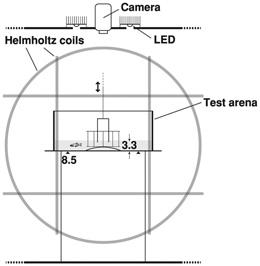Research Abstract
ゼブラフィッシュはグループ依存的な双方向性の定位により地磁気に応答する
Zebrafish respond to the geomagnetic field by bimodal and group-dependent orientation
2012年10月11日 Scientific Reports 2 : 727 doi: 10.1038/srep00727

さまざまな動物が、定位行動の基準として地磁気を利用している。多くの動物の移動や帰巣には、それぞれ独自の磁気感知機構があると考えられているが、その分子機構については、まだ明らかになっていない。本研究では、遺伝学的操作に適したモデル生物であるゼブラフィッシュが、地磁気と同程度の弱さの磁場に応答することを見いだした。地磁気を模した人工的な磁気環境に円形アリーナを設置し、何も訓練していないゼブラフィッシュの磁気に対する選好方位を記録した。同一の親に由来するゼブラフィッシュを個別のグループにして調べた結果、各グループは互いに近い血縁関係にあるにもかかわらず、ほとんどのグループにおいてグループごとに独自の双方向性の定位を示した。ゼブラフィッシュが好む方位は、性別や成長度合い、あるいは周囲の環境因子には依存していないようであり、グループごとの選好方位は遺伝的に決定されていることが示唆された。今回の発見は、磁気感知を担う分子機構に関する今後の研究を促進するものである。
武部 明1, 古谷 俊樹1, 和田 達典1, 鯉沼 正美1, 久保 葉子1, 岡野 恵子1 & 岡野 俊行1, 2
- 早稲田大学 理工学術院 先進理工学研究科 電気・情報生命専攻 分子細胞生物学研究室
- 科学技術振興機構 戦略的創造研究推進事業 さきがけ(JST-PRESTO)
A variety of animals use Earth's magnetic field as a reference for their orientation behaviour. Although distinctive magnetoreception mechanisms have been postulated for many migrating or homing animals, the molecular mechanisms are still undefined. In this study, we found that zebrafish, a model organism suitable for genetic manipulation, responded to a magnetic field as weak as the geomagnetic field. Without any training, zebrafish were individually released into a circular arena that was placed in an artificial geomagnetic field, and their preferred magnetic directions were recorded. Individuals from five out of the seven zebrafish groups studied, groups mostly comprised of the offspring of predetermined pairs, showed bidirectional orientation with group-specific preferences regardless of close kinships. The preferred directions did not seem to depend on gender, age or surrounding environmental factors, implying that directional preference was genetically defined. The present findings may facilitate future study on the molecular mechanisms underlying magnetoreception.

